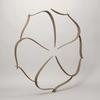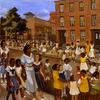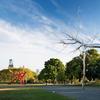'Marisa Merz: The Sky Is a Great Space' Hits the West Coast
- LOS ANGELES, California
- /
- June 13, 2017
The Hammer Museum now presents Marisa Merz: The Sky Is a Great Space, the first U.S. retrospective of the Italian painter, sculptor, and installation artist Marisa Merz (b. 1926, Turin, Italy). Bringing together five decades of the artist’s work, the exhibition includes Merz’s early Arte Povera experiments with non-traditional materials and processes; the enigmatic heads and faces she created in the 1980s and 1990s; and her installations that balance intimacy with impressive scale.
Organized by the Hammer Museum and the Metropolitan Museum of Art, Marisa Merz: The Sky Is a Great Space is on view from June 4 through August 20, 2017 and is accompanied by Merz’s first monograph to be published in English.
“As the only female member of the Arte Povera movement, Marisa Merz has been overlooked for decades and we are thrilled she is coming into a prominence that she so well deserves,” Hammer Director Ann Philbin said. “This exhibition will familiarize audiences with the prodigious talent and influence of Merz’s understudied body of work.”
“The work of Marisa Merz exists in the intersection of art and life that has become so central to contemporary practice,” said Hammer Chief Curator Connie Butler. “Her challenging and evocative body of work is deeply personal, as much a response to her own experience as to art history and the milieu of contemporary Turin and postwar Italy.”
Marisa Merz gained international prominence as part of the circle of artists associated with Arte Povera in the late 1960s. An avant-garde movement that rejected Italy’s material wealth in favor of “poor” materials, Arte Povera was identified with the radicalism of the student movement but proclaimed no stylistic or ideological credo except the negation of existing codes and art world limitations.
- Merz’s earliest work, begun around 1966 in the house she shared with husband, artist Mario Merz, is a tangle of molded aluminum hung from the ceiling that combined sharp, rough metal edges with soft, biomorphic contours, expanding the existing conception of a ‘mobile’ into a colossus.
- In the late 1960s, she went on to create a series of powerful works from non-traditional materials that referenced both her family life and the broader Italian tradition of polymaterialism: sculptures of rolled up blankets bound with nylon thread that were occasionally used as props in performances by her husband; a plywood swing for her daughter that joins sculptural rigor with youthful play; and a series of knitted nylon wire sculptures, including the iconic booties that the artist sometimes wore herself.
- In the 1970s Merz’s trademark installations of humble materials—delicate copper wire, bowls of salt water, knitting needles—grew more and more complex.
- After 1975, the artist began sculpting a series of small heads, often roughly modelled in clay and unfired. These were debuted in the 1980s and would become emblematic of the artist and her late work.
- In the last two decades, Merz’s work has grown even larger and more complex. Individual pieces continue to be integrated into multimedia installations of varying size and intricacy. Her painting and graphic work has also grown more elaborate, combining collage elements and diverse materials including tape, mirrors, binder clips, bottle caps, and metallic pigments, such as recent group of large paintings of winged angels, which contrast a striking beauty with a surprising absence of sentimentality.
After being well received by New York Audiences, The Sky Is a Great Space makes its West Coast debut. Organized in close collaboration with the Fondazione Merz, Turin, the Hammer’s presentation includes drawings and two large floor installations that were not shown at the Met Breuer. The large-scale floor pieces, using tulle, copper wire mesh, lighting equipment, and pipes, evince the signature balance between rough industrial materials and homespun fabrication which have become central to Merz’s signature aesthetic. CATALOGUE This generously illustrated monograph offers readers the chance to appreciate the range of works by Marisa Merz. The book brings together fifty years of painting, sculpture, and installations and offers the first precise chronology of her life and work to appear in print. The most authoritative analysis of her work to date, the catalogue includes previously unpublished texts and poetry by the artist, an illustrated exhibition history, as well as insightful new essays by leading scholars and curators. Contributors include Ian Alteveer, Connie Butler, Carolyn Christov-Bakargiev, Leslie Cozzi, Teresa Kittler, Marisa Merz, Cloé Perrone, Lucia Re, and Tommaso Trini.
See hammer.ucla.edu for a full list of related programs.
















